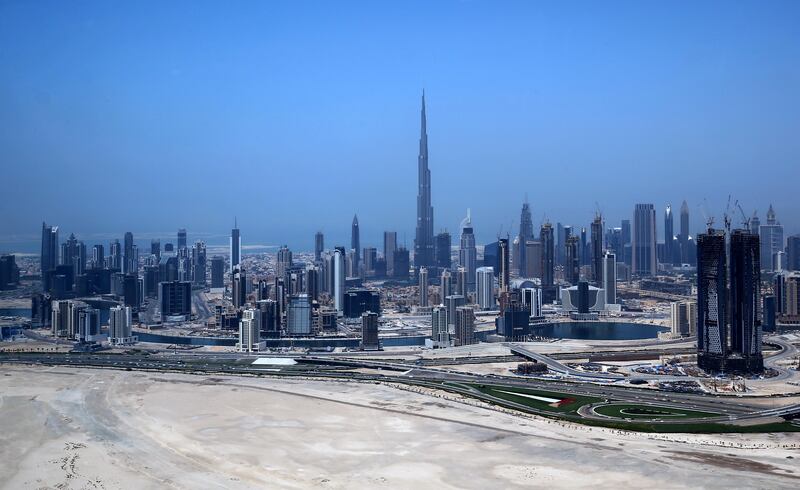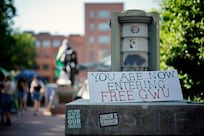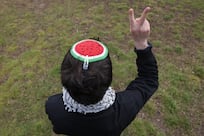Dubai’s transformation from fishing village to global business hub has impressed the world – for its innovation, sheer speed and dynamism. Nowhere is the progress more evident than in the emirate’s architecture.
But now it could be the case that the city's architecture is at a crossroads, an inflection point, as there is a gradual shift from grand to green, and from imposing to approachable. How did we get here?
Back in the 1960s and much of the 1970s, Dubai’s charming traditional architecture with its narrow alleys and wind tower houses still bore testimony to its Bedouin heritage. Dubai was a port town then, and trading was a mainstay of the economy.
The typical image of Dubai in the late 1970s and even into the 1980s was of simple low-rise buildings that were home to thousands of people from across the region and the Indian subcontinent. When the World Trade Centre opened in 1979, it seemed impossibly far away from the centre of the city. But Sheikh Rashid, then Ruler of Dubai, knew what he was doing when he asked the British architect John Harris to build it there. It encouraged the city to expand. And its stylish modernist, concrete-clad design increased its pulling power. In fact, it is the building that you see on the back of the 100-dirham banknote even today.
The WTC was the first of the high-rises that would begin to pop up on the city’s arterial roads, becoming a preferred design statement for the few multinational and even large local companies establishing offices here.
This led to the era of glass towers as the city grew quickly through the 1980s. As George Katodrytis, an architecture professor at the American University of Sharjah, wrote in UAE and the Gulf: Architecture and Urbanism Now: "From the 1980s, exposed glass curtain walls were used extensively in the design of almost every commercial and high-rise building facade in the Gulf … Buildings looked identical. Any discourse on environmental performance and innovation did not exist."
But that era was blown away with the launch of the Burj Al Arab in 1999. The exclusive hotel was the first symbol – and is still the most recognisable one – of Dubai’s arrival on the world stage and its cosmopolitan vision of the future. Soon, Hazel Wong’s Emirates Towers and other extraordinary structures followed, spurring a decade of intense construction activity that saw landmark projects such as the Palm Jumeirah (which literally changed the map of Dubai) and Dubai Marina come to life. Then, in 2010, came the Burj Khalifa, the tallest building in the world and a miracle of modern engineering.
In the years that followed, the influence of architecture has broadened out to create connections across the design sector in Dubai. Local companies in collaboration with intrepid European designers experiment with new forms of architecture, including luxury low-rise floating homes. The recent rise of walkable communities and eco-friendly projects has cemented Dubai’s reputation for constantly reinventing itself.
I believe that when people envision a city of the future, they picture a fast-paced environment brimming with forward-thinking people against a background of skyscrapers, walkable communities and iconic towers. But for Dubai, the future is already here. It is now up to us to continue to innovate, breaking new boundaries and inspiring the world.
While Dubai has always been associated with a penchant for luxury, the growing popularity of ecologically sustainable and integrated built environments reflects a shift in consumers’ and the industry’s perception of the new age of design in the city. Today, architects and interior designers in the region are increasingly opting for recycled materials in their cutting-edge designs, with woven vinyl flooring, reconstituted stone and consciously sourced upholstery taking centre stage.
In Dubai we like to set world records and so it was a sign of the times when, in 2013, a two-storey Dubai store selling eco-friendly products was ranked by the US Green Building Council as the most sustainable building in the world.
Today's architecture takes a wider view than that of the 1980s.
Now Emirati product designers such as Khalid Shafar, Aljoud Lootah and Latifa Saeed, as well as regional designers like Ayah Al Bitar from Saudi Arabia and Fadi Sarieddine from Lebanon are pushing the design frontiers by using their knowledge and experience of local design practices and presenting them for diverse audiences. What makes Dubai even more interesting is the impact that the wide variety of international communities has on the overall design aesthetic in the city – they are ever-receptive to the fusion of global ideas with local practices.
With so much activity, it should come as no surprise that the UAE and Saudi Arabia boast the largest design markets in the Mena region. By 2019, the Middle East will need more than 30,000 design graduates for the sector to thrive, according to a study released by the Dubai Design and Fashion Council. Nearly 90 per cent of growth in the design industry is expected to stem from architecture, interiors and fashion, with architecture and interior design considered the most in-demand creative careers in the region today.
Furthermore, recent research by market analysts Ventures shows that the interior design and fit-out spend in the GCC region is increasing to $17.7 billion this year from $15.5 billion last year. The study attributes the rise to near-constant innovation and ever-changing personal preferences. With all this growth, Dubai is probably one of the world’s most exciting cities for design professionals to advance their careers.
And they'll be doing it in some pretty cool buildings.
Mohammad Saeed Al-Shehhi is chief operating officer at d3





